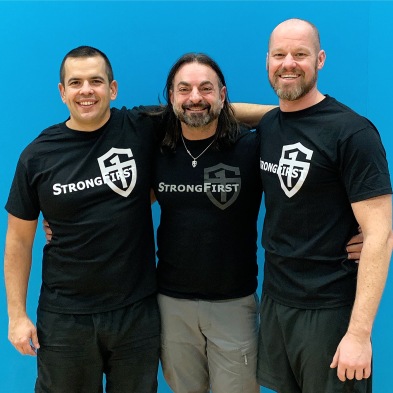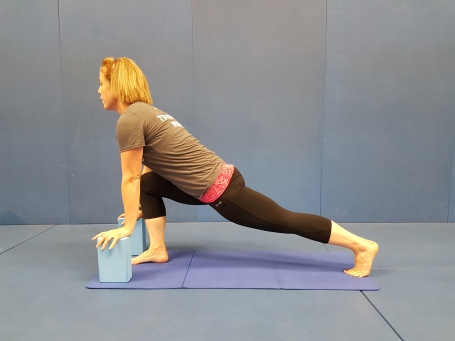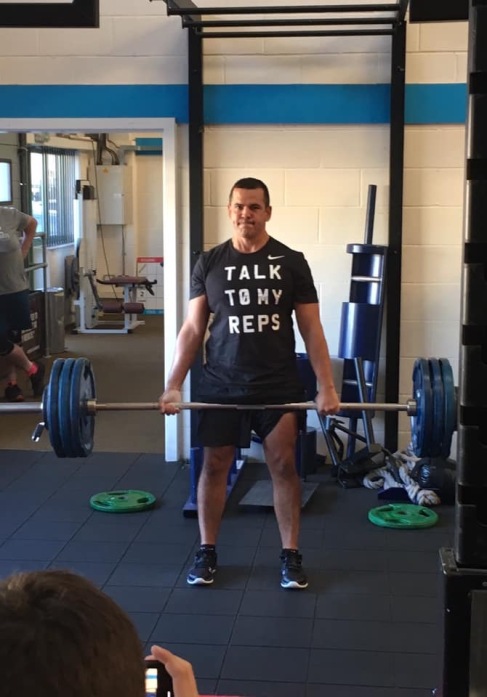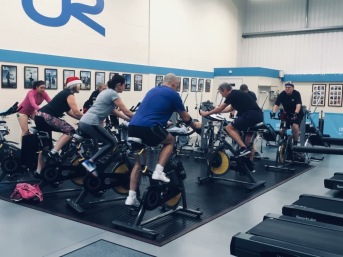This thing that we do (or thing you may be thinking about starting) – ‘going to the gym or fitness studio’ is given a casual name by many – ‘working out’.
The approximate 87% of the UK population who are not a member of a gym/health club/fitness studio have a view of the type of exercise that goes on in these places as getting hot, sweaty, red faced, tired and sore – maybe that’s what puts them off as it certainly doesn’t sound very appealing.

In November 2018 I attended the Strongfirst SFL course (which is a 3 day Barbell Certification). At one stage over the 3 days the Master Instructor who was leading the Certification (Fabio Zonin) sat down and gave an important talk – some of which is inspiration for this article.
What follows are lessons I have learned from over 20 years in the health and fitness industry working with everyday people (and on myself) In the last decade I have worked overwhelmingly with everyday people over 40. When you’re in your teens & 20s you’re pretty much bullet proof. Life hasn’t taken a toll. You most likely still live with parents, don’t have children to look after or a career or business to dedicate a healthy (or unhealthy) chunk on your life to.
The following 5 Categories of gym session are targeted towards men & women over 40 specifically, although those in their 20s and 30s would do well to get ahead of the curve and adopt some of these practices early.
Body Maintenance
A few years ago I was incredibly privileged to host a one day workshop with the fantastic training authority from USA Mark Reifkind about what he called ‘BODY MAINTENANCE’.
This is a regular (ideally daily) practice of foam rolling, stretching, movement and mobility exercises and really just being aware of your body, any aches, pains or tightness and dealing with them BEFORE they become a more serious issue.

This practice could be described as ‘Pre-hab’ or injury prevention. As we get older this kind of practice becomes much more important, especially if you spend much of your time sitting behind a desk at work or sitting in a car or on a train (like many of our members do).
This ‘Body Maintenance’ does not need to be an entire session on its own otherwise many of our members would struggle to get any actual training in each week as time is often limited. I would recommend foam rolling and stretching and preparing your body for the work ahead for 10-15 minutes at the start of each session. You could also build in 10 minutes of movement and stretching to your morning routine (at least a couple of mornings a week or at weekends).
Practice
When you embark on any type of fitness programme or even a new sport there are certain things that you have to learn; movements, techniques, positions, skills etc
If you were LEARNING to box you need to LEARN the guard, how to jab, cross, hook, uppercut, head movement, footwork etc before you could even think about sparring or getting in the ring.
If you were LEARNING to swim you need to gain confidence in the water, learn the different strokes; breast, back, butterfly, front crawl breathing patterns, movement efficiency before you could enter your first race.
When most people walk into a gym they just throw themselves into training from day one and try and get as hot and sweaty as possible (mostly women) or lift as much weight as they can (mostly men) without any prior experience or time to LEARN.
That’s where PRACTICE comes in.
Anything worth doing is worth doing well (and safely). At Unique Results we do lots of strength training with all of our members. This includes things like deadlifts, squats, presses, kettlebell swings, press-ups, pull-ups, lunges etc and these are skills and movements that require PRACTICE.

We take our strength training philosophy from another of my mentors and someone we’ve had the pleasure of hosting at Unique Results a number of times – Dan John.
He talks about (in many of his books) the 5 Fundamental Human Movements:
Push, Pull, Hinge, Squat and Loaded Carry. This is the structure we use when planning programmes and sessions for our members.
You cannot TRAIN a movement until you are proficient at it. That is where practice comes in. To practice a movement you need to feel safe and comfortable and not at all worried about IF you can lift a weight or whether you may get injured if you make a mistake.
When you practice a movement or technique start first of all with no additional load at all, then maybe progress to a light broom handle then an empty bar, then very light weight and progress slowly as your ability and confidence grows.
LEARN and PRACTICE movements to a good standard before you decide to TRAIN them.
Training
So, you’ve done your BODY MAINTENANCE, you’ve learned and PRACTICED some fundamental movements and techniques and now you’re ready to TRAIN.
TRAINING is all about intention and context.
A TRAINING session has a place AND a context, it has a relationship to the previous session and the following session as well. Training is PLANNED and fits within the framework of a bigger goal or outcome. TRAINING is reverse engineered from a bigger purpose and has a desired outcome and result – getting stronger, getting bigger, getting more mobile, increasing endurance, getting faster, losing bodyfat, lifting more, performing better.

TRAINING is planned AND recorded.
TRAINING is not random, it is not done on a whim, it is structured and purposeful.
Training requires thought, presence, focus and discipline.
Workout
WORKOUTS are what most people do when they go to a gym.
Wander round and see what equipment is not currently being used by anyone else and ‘do a bit’ on it before wandering onto the next random exercise.
There is nothing wrong with ‘WORKING OUT’. A ‘WORKOUT’ is a single session with no relationship to the previous or next session. It can exist totally on it’s own as a singular event. A ‘WORKOUT’ could be done to blow off some steam at the end of a long day. To help you wake up in the morning. To help you get over a hangover. Just because you feel like you want to sweat and get some endorphins pumping through your blood. To FEEL good.

I often do ‘WORKOUTS’ when I’m away on holiday. If I’m in an unfamiliar gym with limited space or equipment I just do the best I can with what I have and do some exercise for the physical and mental benefits that it brings. The sessions may bare no relationship to each other and not be part of a grander scheme or bigger picture.
Spinning (indoor cycling) for me is a ‘WORKOUT’. I teach 3 x 45min Spinning classes each week and I really enjoy them. I get a good sweat on, I enjoy the music, I love the people, I feel great afterward AND its good for my health BUT I don’t consider it TRAINING – It’s not specifically working towards any goals I currently have, however, it still has value as is better than sitting on the couch or in the pub. Try and have more TRAINING sessions than WORKOUT sessions. More sessions with context and thought behind them than not.
HOWEVER
A WORKOUT for someone may be a TRAINING session for someone else.
A road cyclist may use Spinning classes in the winter months to keep up their mileage and fitness while its cold, dark and wet so that when Spring comes they’re fit to get straight out on the bike again.
Interval running sprints may be a WORKOUT for some, a way of burning calories, expending energy, getting hot and sweaty and feeling good BUT for a competitive runner the same sprints may be TRAINING as a way of keeping speed in the legs and building strength.
As with much in life, context is key.
Injury/Illness rehab

If you’ve done your BODY MAINTENANCE regularly, your PRACTICE, your planned TRAINING sessions and some sensible (fun) WORKOUTS you will have grown more durable, robust and minimised your risk of injury (especially if you have worked with qualified and experienced trainers or coaches). HOWEVER if you are going to embark on an active lifestyle and not wrap yourself in cotton wool and live life on the couch you MAY at some time pick up an injury or niggle that needs addressing.
If that does happen then consult with qualified, experienced professionals such as physiotherapists, osteopaths etc. They can help build a programme of rehabilitation. This again is a category of session all on it’s own.
While you are rehabbing one injury it may still be possible to sensibly TRAIN around it.
If you do pick up an injury, be patient. Don’t rush back to training too hard, too soon and always take the advice or trusted advisers around you.
In Conclusion.
As you get older – into your 40s, 50s, 60s and beyond staying fit, healthy and active gets more, not less important BUT you have to be sensible and considered with what you choose to do and how you choose to do it. Know your ‘WHY’. What are you training for? what are your outcomes and goals?
Make time for the 5 (hopefully mainly 4) categories of sessions we have discussed in this article. Plan the work and then work the plan.
Consult with qualified and experienced experts who have a proven track record with working successfully with other people like you.
There are usually very few barriers to improving your health and fitness at ANY stage of life BUT as you get older take additional time to rest, recover and recuperate between sessions and remember to address any niggles through BODY MAINTENANCE before they become more serious. If in doubt, ask for help.
FEEL healthy, LOOK healthy, BE healthy.
James St Pierre